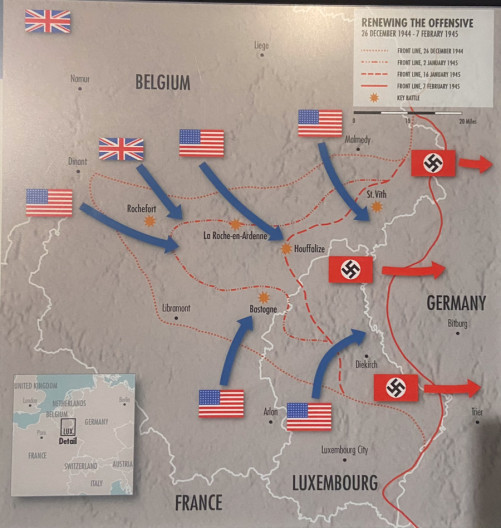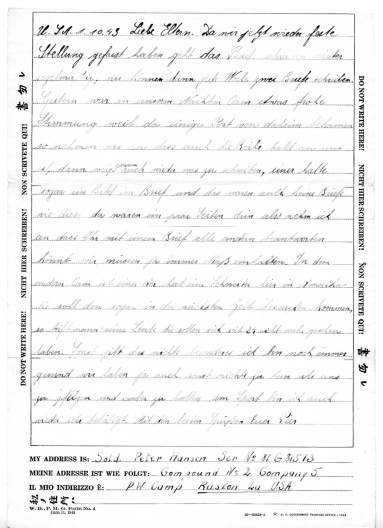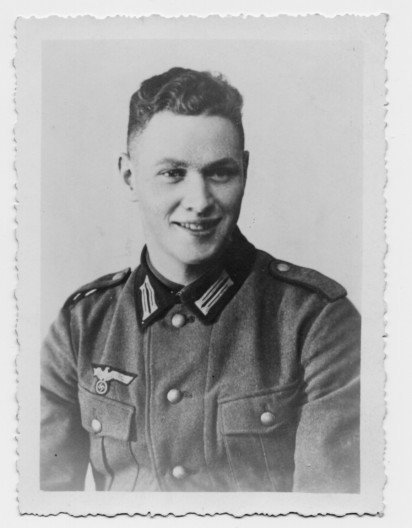The Second World War is an immensely significant global conflict, in which the United States played a prominent and pivotal role in two main theatres, namely the Pacific and European fronts. Within the collective memory of Americans, it is widely recognized as the 'Good War,' symbolizing the extraordinary courage and unwavering determination of the 'greatest generation' who valiantly fought alongside their Allies to defeat German fascism and Japanese imperialism. However, finding information about smaller nations and their specific contributions, such as Luxembourg, can be challenging. Luxembourg is often overlooked, downplayed, or omitted in maps and historical accounts. Nonetheless, the question remains: why is Luxembourg important? What makes this small country significant in the context of World War II?
During June 2023, the author had the privilege of serving as a visiting fellow at the prestigious National WWII Museum in New Orleans. During this period, the author participated in an intensive program focused on military history education and had the opportunity to conduct extensive research using the museum's extensive collections and library, with a specific focus on the role of Luxembourg during World War II.
Luxembourg, recognized by U.S. military historians, played a significant role in the Battle of the Bulge, a major military engagement that occurred between December 16, 1944, and January 25, 1945. This battle, initiated by German forces, was a surprise offensive aimed at dividing and conquering the Allied forces. The German strategy involved creating a prominent "bulge" in the American lines, which ultimately led to the battle's name. Initially caught off guard, American troops encountered relentless German attacks compounded by severe winter weather conditions. The Germans aimed to recapture the strategic port of Antwerp and deliver a decisive blow to the Allies. Despite the challenges faced, the American troops demonstrated remarkable resilience and bravery.
The Battle of the Bulge marked a crucial turning point in World War II. The American forces, despite being initially surprised, successfully defended their positions and thwarted the German offensive. The outcome of this battle severely diminished German capabilities and set the stage for the final Allied push towards Berlin. However, the American troops faced challenges during the battle, enduring casualties, while individuals recall the bitter and cold winter conditions in the North of Luxembourg (as depicted in a picture showcased at the WWII Museum).
Luxembourg holds a significant position in the events of the war, resonating with many Americans who have a keen interest in World War II history. However, it is crucial to acknowledge that events like D-Day and the Battle of Iwo Jima continue to occupy important and pivotal positions within the collective memory of the war.
The Museum Collections
The National World War II Museum houses an extensive collection of historical resources, including thousands of oral histories and hundreds of thousands of photographs related to the war. Their website allows visitors to explore a selection of these collections. Additionally, for researchers like myself, they offer access to an even more substantial repository of documents and videos, totalling a thousand more resources. During my time as a fellow, I had the invaluable opportunity to conduct research focused on Luxembourg and its impact on American war experiences.
Notably, the collection features accounts of individual encounters between American troops and Luxembourgers, particularly with residents during the Battle of the Bulge. These records provide valuable insights into the personal interactions and experiences that occurred during this critical historical event.
In interviews conducted by the WWII Museum, American soldiers predominantly recall the hardships endured during the Battle of the Bulge and the severe winter conditions. One such account is from Reginald Duncan, born in 1922. Duncan recounts being deployed to Huldange as part of an engineering unit assigned to repair streets for the movement of American troops.1
During their deployment, Duncan and his unit found lodging in a house belonging to a father and daughter. While the father held pro-German sentiments and harboured dislike for the Americans, Duncan discovered a stark contrast in the daughter's attitude. She displayed friendliness and provided support to the American soldiers. Over the course of a few weeks, as they tirelessly worked on repairing the streets of Northern Luxembourg, Duncan formed a fondness for the daughter. She went above and beyond, not only by washing their clothes but also by actively aiding them in their endeavours. This personal account provides a poignant glimpse into the profound individual connections that were forged amidst the challenging circumstances of war.
Another American soldier, Donald Carter, born in 1925, recalls a particular incident during his time in Luxembourg.2 One of his comrades decided to leave his post at night and ventured into an abandoned house where he discovered a bottle of "Calvados," an apple brandy. He consumed the entire bottle, becoming intoxicated. As a result of leaving his post and being found in an inebriated state, he was apprehended by the Military Police. Carter was tasked with escorting the intoxicated soldier to Luxembourg City to face an American Army Court Martial. Carter provided testimony against his drunken comrade. Based on the absence of a specific date in Carter's account, this event likely occurred after January 1945. This brief episode highlights a different facet of the American war experience, wherein even after the liberation of the country, American troops continued to be deployed.
Another interview features Fred Gordon, born in 1918, recounting his journey through Northern Luxembourg and his combat experiences as an artillery gunner.3 He describes setting up his cannons in Consdorf in a chateau and later in Beaufort, playing a crucial role in creating a path for the Americans to overcome the Nazi German army.
These accounts, though brief, provide glimpses into the larger narrative of World War II. They clearly illustrate the presence of Luxembourg and Luxembourgers in various sources and interviews, underscoring Luxembourg's significant role in the course of the war.
The WWII Museum's exhibition on the Battle of the Bulge, as depicted in the accompanying picture showcasing Luxembourg, sheds light on the intense fighting and civilian devastation that occurred in the northern part of the country. This period represents a dark chapter in Luxembourg's history. However, despite these grim events, references and information pertaining to Luxembourg can be found within numerous holdings and archives. There is a growing interest in conducting further research on Luxembourg-related topics, such as Luxembourgers in Allied captivity.4
Luxembourgers in the US during the WWII
As a historian specializing in Luxembourgish history and actively involved in the WARLUX project, Luxembourg naturally holds a central focus for my work. While participating in the Summer Seminar organized by the WWII Museum, I seized the opportunity to thoroughly explore the museum's collections.
As a researcher with a particular focus on the war experiences of Luxembourgers who served as German soldiers during World War II, my primary interest lies in understanding their draft process, combat engagements, and ultimately their capture. Specifically, I have delved into an article that explores the Luxembourgish soldiers' involvement on the Eastern Front, highlighting their defection from German forces and subsequent capture5 (with significant contributions from my colleague Inna Ganschow's research6).
Furthermore, I am keen on investigating the experiences of Luxembourgish soldiers as German prisoners of war (POWs), including those who were forcibly conscripted from Luxembourg and held captive by the Allies. While the exact number of soldiers with Luxembourgish origins remains unclear, it is known that approximately 2,000 Luxembourgers were captured by Soviet forces.7 It is important to note that the total number of Luxembourgish soldiers, including those of non-German origin from regions like Alsace, Lorraine, Eupen-Malmedy, Silesia, and other non-German areas, either recruited based on their ethnic German heritage or volunteered by the Allies, is yet to be determined.
The experiences of Luxembourgers as German soldiers during World War II, including their draft, combat engagements, and capture, are indeed portrayed in various archives and holdings in the United States. While the National WWII Museum primarily focuses on public history and exhibitions related to American involvement in the war, it still maintains a comprehensive collection of materials related to the WWII, including an extensive library.
However, further research is necessary to delve deeper into the specific experiences of Luxembourgers during the war, and expertise from colleagues, such as Dr. Stephanie Hinnershitz, who work on the Home Front, and the work of German and Luxembourgish POWs, would be invaluable in shedding light on this fascinating and relatively unexplored topic.
One example that has been documented is the case of Private Nicolas Weber, a POW from Luxembourg, who experienced challenges due to his anti-Nazi political beliefs. He felt endangered and was placed under special observation at Camp Claiborne in Louisiana. Major Henry Draper, the Commanding Officer of Camp Claiborne, personally investigated the case and reported to the Office of the Provost Marshal General (OMPG) that Private Weber was genuinely anti-Nazi and not trying to avoid being transferred. As a result, Private Weber was transferred to Camp Butner, North Carolina, in May 1945, in order to ensure his safety. This case provides insight into the complexities and nuances of the experiences of Luxembourgish POWs during the war, highlighting the importance of conducting further research to better understand their stories.8
As this case of Nicolas Weber is portrayed in the National Archives and Records Administration (NARA) in Maryland it would be essential to further explore the experiences of Luxembourgers and other non-German soldiers during World War II. As exemplified by Nicolas Weber's case, the relationship between Luxembourgers and other non-German captives with their German counterparts was likely complex and challenging.
Many Luxembourgers, including individuals like Nicolas Weber and Pierre Hansen (born 1921) from Schifflange, were transferred to camps in the Deep South of the United States, such as Camp Livingston in Louisiana. Pierre Hansen, in particular, was stationed at Camp Ruston in Louisiana, among other locations. Our WARLUX project's crowdsourcing campaign and information on Pierre Hansen revealed letters from the POW camps. These letters provide valuable insights into the experiences of Luxembourgers during captivity, expressing feelings of boredom, longing for news from loved ones in Schifflange, and anxiously waiting for the war to end. The publication of these letters on the forthcoming project website will undoubtedly contribute to a better understanding of the human side of the war for Luxembourgers and other POWs.
Despite the scarcity of available materials, the research expertise at the National WWII Museum in New Orleans, coupled with the letters from Pierre Hansen, assists in reconstructing the war experiences of Luxembourgers across the Atlantic. Even though they were no longer actively deployed in battle, the impact of the war persisted for Luxembourgers, exemplified by Pierre Hansen's return home to Schifflange in December 1945.
Although the individual documents specific to Luxembourgers are absent from the WWII Museum collections, they still provide relevant materials that contribute to further research, as demonstrated by the case of Nicolas Weber. Numerous additional files await exploration in Washington, holding the potential to reveal further insights.
- 1. Duncan, Reginald. Oral History Interview. OH.4134. Oral History Collection, National World War II Museum, New Orleans, LA. http://netx-util-01/app/#asset/73029/overview. Accessed June 30, 2023.
- 2. Carter, Donald. Oral History Interview. OH.5691. Oral History Collection, National World War II Museum, New Orleans, LA. http://netx-util-01/app/#asset/118942/overview. Accessed June 30, 2023.
- 3. Gordon, Fred. Oral History Interview. OH.3829. Oral History Collection, National World War II Museum, New Orleans, LA. http://netx-util-01/app/#asset/62817/overview. Accessed June 30, 2023.
- 4. Find out more about the Battle of the Bulge in Luxembourg, http://www.mnhm.net/mnhm/index.php/explore/battle-of-the-bulge.
- 5. Nina Janz, Luxembourgers at the Eastern Front, in: The German Soviet-German, edited by Jeff Rutherford (Cornell University Press, 2024), forthcoming.
- 6. Upcoming article “Paper and ink in the Soviet camp 188 in Tambov: capturing the camp life of Luxembourger conscripts”, https://orbilu.uni.lu/handle/10993/52581.
- 7. André Hohengarten, Die Zwangsrekrutierung Der Luxemburger in Die Deutsche Wehrmacht. Eine Dokumentation., ed. Centre de Documentation et de Recherche sur l’Enrôlement forcé, vol. 1, Histoire & Mémoire. Les Cahiers Du CDREF (Luxembourg: Centre de Documentation et de Recherche sur l’Enrôlement forcé, 2010), 9.
- 8. Claire DeLucca, ‘Both Sides of the Barbed Wire: Lives of German Prisoners of War and African Americans in Camp Claiborne, Louisiana, 1944-1946’ (Master, New Orleans, New Orleans, 2018), 22.







